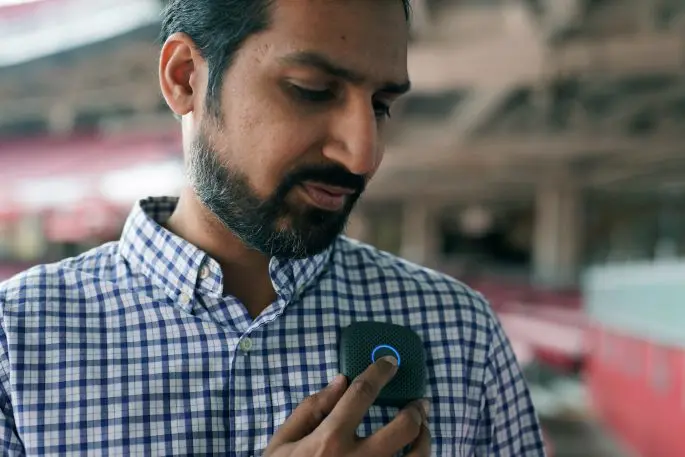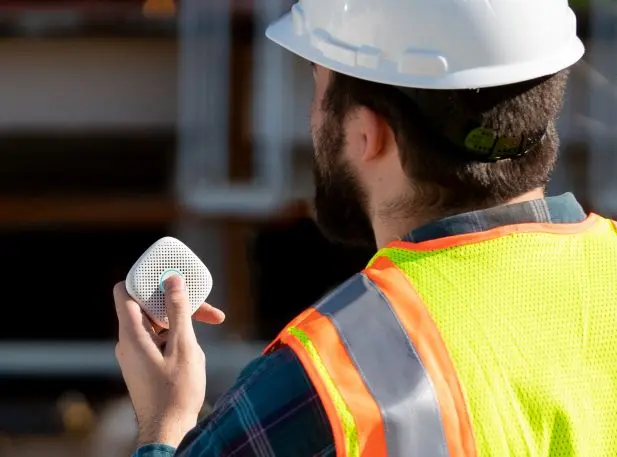A few months ago, the website for the startup Relay was adorned with smiling children and glowing testimonials from parents, illustrating how the $50 push-to-talk device would let parents chat with their kids and track their whereabouts without giving them cellphones.
But despite the family-friendly façade, companies in the hotel, amusement, and concessions businesses saw huge potential in Relay: instead of using the small, squarish devices to help parents communicate with kids, what if they could be used to replace bulky and expensive walkie-talkies? Some of these businesses started placing orders, and Relay took note.
“Demand sort of showed up at our doorstep,” says Chris Chuang, Relay’s cofounder and CEO.
Now, Relay is rolling out a proper enterprise version of the product, with staid black and white color options and features specifically for business use, particularly for companies that have large numbers of employees who are out and about, not sitting behind desks. Relay’s push-to-talk button serves as a quick way for workers to get in touch, and it even doubles as a panic button, letting construction crews or housekeepers rapidly send an emergency message. Relay also now offers a web app for businesses, so managers can communicate with their team’s Relay devices through a laptop. Instead of just targeting an audience of worried parents, Relay hopes to take a piece of the nearly $3 billion walkie-talkie market.
The anti-smartphone
Relay is an offshoot from Republic Wireless, a wireless carrier that repackages access to the major networks such as Sprint and T-Mobile. When Republic launched in 2011, unlimited calling and text messaging wasn’t yet standard, so its big selling point was its use of Wi-Fi to offer unlimited calls and text messages, only falling back to cellular as a last resort.

“We always had multiple segments in mind—kids, seniors, and businesses—but we wanted to start with kids because we had a real problem in our households,” he says.
Although it doesn’t look like a smartphone from the outside, the Relay is similar on the inside, with 4G LTE radios, Wi-Fi connectivity, GPS for location tracking, a Qualcomm chipset, a headphone jack, and a battery that lasts roughly two days on a charge. The main difference, of course, is that it trades a touchscreen for a big button, which users can press and hold to talk with fellow Relay users over a cellular or Wi-Fi connection. Parents could then talk to their children through their own Relay devices or through Relay’s mobile app, which would also let them monitor their children’s location. The idea was to provide the connectivity of a smartphone without the addiction of yet another screen.
Chris ChuangDemand sort of showed up at our doorstep.”
Chuang says Relay has “tens of thousands of customers” for the family version, but it turns out that the same properties that made Relay work for kids—durability, simplicity, cost-effectiveness—also appealed to businesses. While walkie-talkie apps do exist for smartphones, the touchscreen requires “active workers”—that is, those in fields like construction and hospitality—to stop looking at what they’re doing. Smartphones would also invite distraction from social media and other apps.
This helps explain why walkie-talkies have stuck around in the smartphone era, but they have their own problems. Most of them are large and heavy, so they’re impractical for workers that don’t have an easy way to tote them around, and the costs are as steep as a smartphone, ranging from several hundred dollars to over $1,000 per unit.
“These devices, they haven’t changed much from the Nextel days,” Chuang says.

“The price point enables people to now arm more of their workforce,” Chuang says. “Our vision is really to connect every active worker, whereas today where you have to ration out the walkie-talkies.”
Taking on big walkie-talkie
One of Relay’s first enterprise customers was the concessions giant Delaware North, which began testing consumer Relay units last year. Andrew Worden, Delaware North’s general manager at the Great American Ballpark in Cincinnati, says his IT manager came across Relay on his own while looking to replace walkie-talkies that were nearing the end of their lives.
“The costs continue to rise on the traditional radio,” Worden says. “Because [our business is] seasonal-based, it’s hard to justify spending $500 to $1,000 to replace a number of [walkie-talkie] radios.”

Chris ChuangThese devices, they haven’t changed much from the Nextel days.”
“All in all, it’s been an effective way of communication, and it’s allowed us to cut our costs,” he says.
David Palumbo, the general manager for Marriott City Center in Raleigh, N.C., gave a similar story. While looking for walkie-talkie alternatives, he received a referral from a colleague who was familiar with Relay. The hotel is currently using them for its security, housekeeping, engineering, front-office, bell stand, valet, and banquet departments, and plans to expand to its culinary and restaurant staff.
“This, quite frankly, was a tremendously more cost-effective solution and was much more flexible than a standard walkie-talkie,” he says.
Palumbo notes that Relay has also been able to add new features in response to his requests. For example, after sending out a message to all channels in an emergency, he can have Relay automatically switch back to individual channels after set a period of time.
“If there was something that we would like to see it be able to do, they were able to program it, and within a couple days, activate it with very few exceptions,” Palumbo says.
If there’s a potential Achilles heel for Relay, it’s the unreliable nature of cellular and Wi-Fi networks. Try to make a call during a big sporting event, for instance, and you can easily see why businesses might not want to ditch walkie-talkies outright.
“Regardless of having 30,000 or 45,000 people in the area, we know it’s going to work,” Delaware North’s Worden says of standard walkie-talkies. “We haven’t seen those issues with Relay, but you never know. When you’re a wireless or cellular-based solution, there’s always going to be that question mark.”
The future of push-to-talk
Although the walkie-talkie business is unglamorous, it’s arguably ready for some disruption. According to Maia Research Analysis, the market has grown in revenue by over 8% every year for the past three years, and the group expects that trend to continue through at least 2024, at which point revenues could exceed $4.8 billion. Despite being more than 75 years old, the walkie-talkie isn’t slowing down.
Relay’s Chris Chuang argues that major vendors such as Motorola, which alone has 50% of the market, don’t have the expertise in smartphone-like hardware, software, and networking to make a product like Relay. But perhaps more importantly, walkie-talkie makers currently enjoy gross profit margins of over 40% on devices that can cost hundreds of dollars; they may not want to cannibalize that business with hardware that sells for a tenth of the cost. He notes that while Motorola has started offering cellular connectivity in some of its radios, the feature is only available on high-end models as a profit booster.
Although the walkie-talkie business is unglamorous, it’s arguably ready for some disruption.
“A disruptively priced product like Relay would threaten their existing revenues greatly,” he says.
Still, Relay may not need to completely upend the walkie-talkie business to succeed. By virtue of being lighter and cheaper, it may appeal to workers who otherwise might not use a walkie-talkie at all. Schools, for instance, might want to equip their teachers with something lightweight for emergencies, and housekeepers could use them as protection against abuse, especially with a wave of state laws mandating panic buttons for hotel staff.

Down the road, Chuang even sees Relay powering a kind of workflow automation system for active workers. With speech recognition, a concession worker might be able to put requests into a resupply queue, and with automation tools, managers might be able to schedule messages for their staff. Chuang doesn’t like to say it publicly, but internally Relay thinks of itself as a Slack for active workers, the implication being that it’s a platform whose usefulness will extend as more businesses get on board.
“As we get with customers, they brainstorm almost as much as we do,” he says.
Recognize your company's culture of innovation by applying to this year's Best Workplaces for Innovators Awards before the extended deadline, April 12.
